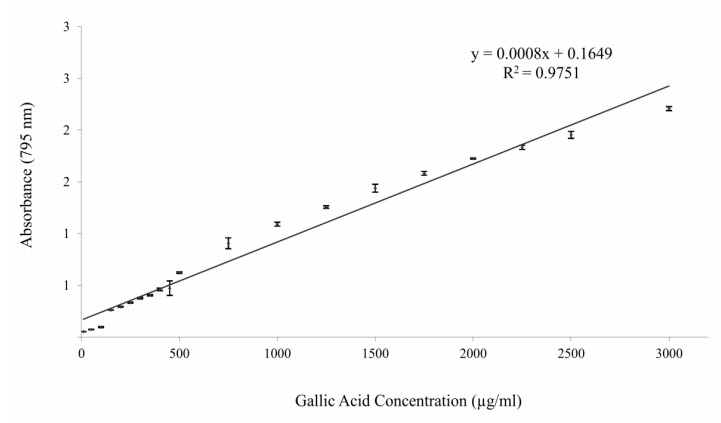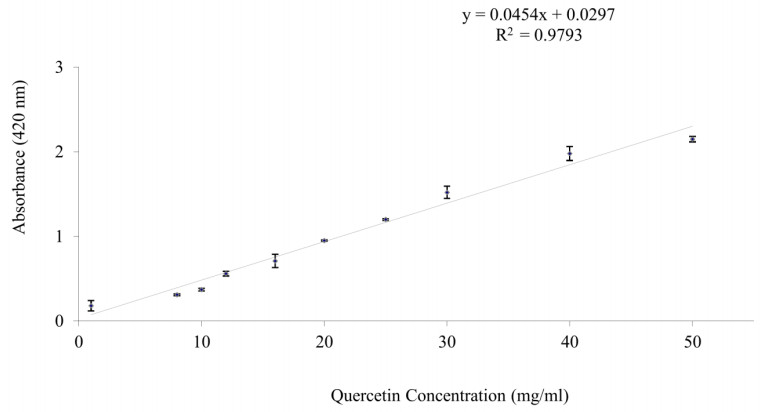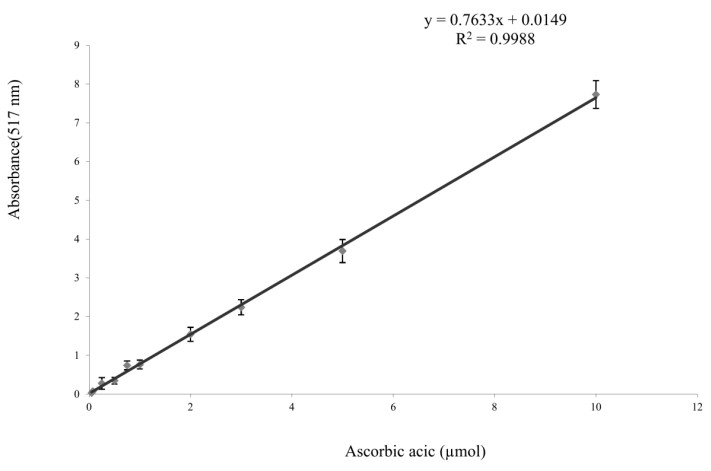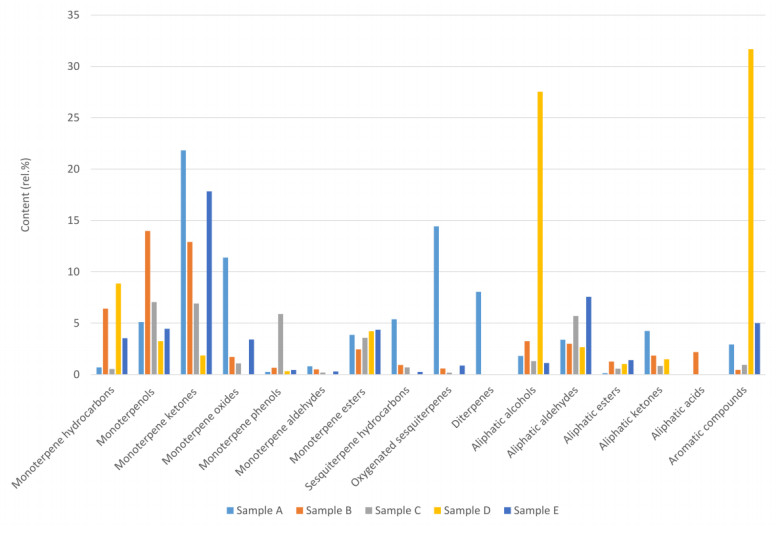This study determined the chemical composition of volatile components and antioxidant properties of Allium jesdianum (AJ), Nasturtium officinalis (NO), Eremurus spectabilis (ES), Tragopogon graminifolium (TG) and Falcaria vulgaris (FV) which grow in the west of Iran. Total phenol content, total flavonoid, free radical scavenging ability (by IC50 value of DPPH test) and total antioxidant capacity were measured using Folin-Ciocalteu assay, aluminium chloride colorimetric assay, the DPPH and the phosphomolybdate method, respectively. The total antioxidant capacities of AJ, NO, ES, TG, and FV were 1.03±0.01, 1.39±0.09, 2.41±0.42, 0.79±0.08, and 1.20±0.13 (μmol ascorbic acid/gram of dry extract), respectively. Total flavonoid contents of AJ, NO, ES, TG, and FV were 21.55±1.22, 33.05±8.80, 18.32±2.30, 32.16±9.46 and 23.06±3.21 (mg quercetin/gram of dry extract), respectively. Total phenol content of the plant extracts ranged from 250.91 to 702.69 mg of gallic acid/gram of dry extract. NO has the highest DPPH scavenging activity with the lowest IC50 value (1654.75±857.56 μg/mL of extract) and AJ has the lowest DPPH scavenging activity with the highest IC50 value highest (8538.33±563.96 μg/mL). The investigated traditional Iranian edible plants are rich in different types of chemical compounds and are good available sources of natural antioxidant compounds.
Abbreviations: AJ: Allium jesdianum; NO: Nasturtium officinalis; ES: Eremurus spectabilis; TG: Tragopogon Graminifolium; FV: Falcaria Vulgaris; IC50: The half maximal inhibitory concentration; HS-SPME: Headspace solid phase microextraction; GC/MS: Gas chromatography–mass spectrometry; DPPH: 1, 1-diphenyl-2-picrylhydrazyl; GAE: Gallic acid equivalents; PDMS/DVB: fiber Polydimethylsiloxane/Divinylbenzene; ANOVA: One-way analysis of variance
1.
Introduction
Plants are of great importance for their medicinal and nutritional properties and as primary sources of bioactive compounds. Plants and plant products are found throughout human history as herbal supplements such as botanicals, nutraceuticals, and drugs. About 60–80% of the world's population relies on traditional medicine for the treatment of common illnesses [1]. Plants have always played an important role in the treatment of many diseases, especially in countries in the eastern region. Iran has an ancient history of using herbal medicines and old documents demonstrate that Persians were pioneers in applying plants for medicinal purposes [2]. Lorestan is a province in western Iran, situated along the Zagros Mountains, and has intact nature and widespread plant flora. In this province, 151 native medicinal plants have been identified which are used as traditional treatments for different diseases [3].
Phenols are secondary metabolites of plant-derived and include a large group of compounds that contribute majorly to the human diet. Herbal phenols are chemically heterogenous compounds with approximately 10,000 different variants. They posess free radical scavenging activity and play a major role in human health [4]. Flavonoids and flavones are abundant in plants in free form or bound to glycosides [5]. These compounds reside in leaves, fruits, vegetables, seeds, plants, stems, and flowers. Flavonoids are one of the most common natural compounds with special medicinal properties [5]. Flavonoids are found in all forms of plant foods and have well-established antioxidant effects. Polyphenols and flavonoids have the potential to inhibit the activity of free radicals and delay lipid peroxidation [6,7]. Nowadays, the consumption of synthetic antioxidants has been limited due to their increased toxicity, and natural antioxidants have become more appealing in medical communities [8].
Using medicinal herbs necessitates knowing about their scientific information and the characterization of their chemical compounds, including volatile and non-volatile ones, since they are responsible for the therapeutic and bioactive effects. Notwithstanding presence of the known antioxidant compounds such as polyphenols, flavonoids and α-tocopherol in the nonvolatile fraction of plants, some other components with antioxidant potential such as antioxidative volatile terpenes exist in the aroma extracts [9]. Traditional medicinal herbs have been frequently used in Iran. Therefore, discovering their chemical composition and their bioactive effects such as antioxidant properties is of special significance. Few studies have been conducted concerning volatile compounds and antioxidant properties of medicinal plants grown in Lorestan province, including Allium jesdianum (AJ), Nasturtium officinalis (NO), Eremurus spectabilis (ES), Tragopogon graminifolium (TG), and Falcaria vulgaris (FV).
AJ belongs to Lilaceae family. It was found at 1800–2600 meter height of Zagrows mountain. Native peoples used its aerial part for treatment of some diseases like abdominal pain, rheumatism and kidney stones. The presence of steroids in its roots also causes cytotoxic and cytostatic effects against malignant tumor cells [10,11,12].
NO belongs to Brassicaceae species and generally grows in central and western Europe, but today it has been extended all over the world and in various parts of Iran including; Karaj, Lorestan, Kermanshah [13]. NO has various protective vitamins and can be used in the treatment of chronic metabolic diseases. In the late nineteenth century it has been used as a refining blood factor and also in the treatment of pulmonary diseases [13,14,15]. In traditional medicine, NO has been used as a sputum, diuretic and anesthetic [15]. This plant has been recommended for reducing blood sugar in diabetes and for treatment of rheumatism, gout disorders, kidney diseases, tuberculosis and Jaundice [13,14,15,16,17]. NO contains important dietary components such as iron, iodine, calcium. It has been known as a vitamin C-rich plant for a long time, so it is used for curing approaches. Various studies on the antioxidant properties of this plant has been accomplished. NO is similar to Brassicaceae species, because of containing glucosinolate compounds and having anti-cancer properties [18,19]. This plant has free radical scavenging and antioxidant substances such as flavonoids in its structure [20,21,22,23,24].
ES, locally known as 'Ciris', is widely used in Iran as a wild edible vegetable and has been traditionally used in folk medicine to treat some ailments such as hemorrhoids and diabetics, and also used as antidysuria and antihypertensive [26]. People living in the Eastern Anatolia are extremely experienced with inadequate yields due to adverse climatic and inappropriate topographic conditions [25].
TG family Composite, is a perennial plant [27]. Different species of Tragopogon are used for their anticough, astringent, skin repairing, and vulnerary properties, and have beneficial effects in gastrointestinal disorders [28,29]. TG's aerial parts and root parts have been used in traditional Iranian medicine for their astringent, antiseptic, anti-inflammatory, poison elimination, anti-hemorrhagic, and wound healing activities, as well as a liver and stomach tonic, and for use in the treatment of gastrointestinal ulcers, liver disorders, haemorrhage, pulmonary infections, and wounds [30,31]. The plant is widely consumed in the west of Iran as a green vegetable in food and salads and also for medicinal purposes.
FV (locally named ghazzyaghi/poghazeh), a member of Apiaceae family, is consumed as a vegetable in some regions of Iran including Lorestan Province, for healing of skin ulcer, stomach disorders including peptic ulcer, liver diseases and stones of kidney and bladder. Naturally, this plant exists for a short time [32]. The species contains essential oil, vitamin C, phytoestrol, protein and starch [33].
Since there are few studies about the properties of the above-mentioned plants, the aim of the current study was to determine the chemical compounds of their volatile fraction (using HS-SPME-GC/MS method, as a novel method for their analysis) and antioxidant properties (total phenols, flavonoids, radical scavenging activity by IC50 of DPPH test and total antioxidant capacity) of their extract.
2.
Materials and methods
2.1. Materials and reagents
The Folin-Ciocalteu reagent, DPPH (2, 2-diphenyl-1-picrylhydrazyl), gallic acid, and disodium hydrogen phosphate used in this study were obtained from Merck Company. Quercetin and ascorbic acid and other solvents and chemicals were purchased from Sigma.
2.2. Plants and sampling methods
Plant samples were collected from nature in different areas of Lorestan province in April and May, 2017. Information about these plants is shown in Table 1. The vegetative bodies were cleaned and washed with water. Then, samples were allowed to stand in room temperature away from sunlight and were air-dried for several days. Dry samples were powdered using a clean grinder. Finally, powdered samples were kept at 4 ℃ in a dark and dry environment. Active components were determined in the chemistry lab of Razi Herbal Medicines Research Center.
2.3. Extraction
To prepare extracts by maceration, 50 mL of methanol (80%) was added to 5 g of dried powdered plant material. The solution was kept at room temperature for 72 hours and stirred every 4 or 5 hours, and was filtered through filter papers. Chlorophyll was removed by a two-step liquid-liquid extraction with hexane (1:1, v/v) [34,35]. The extracts were subjected to a rotary evaporator under a vacuum at 40 ℃ to remove the solvent, and then freeze dried. The resultant dried extracts were kept at 4 ℃ for further phytochemical analysis.
2.4. Determination of total phenol content
The contents of total phenolic compounds in the plant extracts were measured using the Folin-Ciocalteu method [36]. One mL methanol was added to 10 mg of dry extract. Then, 200 µL of Folin-Ciocalteu reagent was added to 40 µL of the extract, and the solution was diluted with 1000 µL distilled water. Afterwards, 600 µL sodium carbonate was added, and the samples were allowed to stand for 2 hours at room temperature in darkness. Finally, the amount of light absorbed by the solution was measured by spectrophotometry at 765 nm. The standard curve was drawn based on different amounts of gallic acid, and the concentration of total phenolic compounds was expressed as (GAE) in milligrams per gram of dry plant extract.
2.5. Determination of total flavonoids
Total flavonoid contents were measured using aluminum chloride colorimetric analysis with quercetin as the standard [37]. First, standard solutions with concentrations of 0–100 mg/L were prepared from quercetin in absolute methanol. Then, 0.2 mL 2% AlCl3 and 0.1 mL of 33% acetic acid were added to 0.2 mL of plant extract or standard solution. The solution was vortexed, and then the volume was brought to 5 mL using ethanol (90%). After 30 minutes, absorbance was recorded at 420 nm, and total flavonoid content was obtained by a standard curve based on mg of quercetin equivalent per gram of dry plant extract.
2.6. 2, 2-diphenyl-1-picrylhydrazyl (DPPH) assay
To analyze the antioxidant activity of the alcoholic extract of plants, the inhibition of the production of free radicals was measured using the DPPH method [8]. Then, 200 µL of samples with various concentrations were mixed with 1 mL of 90 µmol DPPH, and the volume was increased to 4 milliliters with methanol (95%). The solution was shaken in darkness for 1 h. Then, absorbance was measured at 517 nm. The percentage (%) of DPPH scavenging effect was calculated based on the following equation:
where I% = the percentage of DPPH scavenging effect, Ablank = absorption in negative control and Asample = of samples. To compare the scavenging effect of the extracts, the results were reported as IC50 values. IC50 value was the required concentration of extract to scavenge the free radicals of DPPH by 50%. The higher antioxidant power, the lower IC50 value. Using the Excel software program, a diagram was drawn based on the I% and the concentration of the extracts. The resultant equation was used to calculate IC50 based on µg/mL. All samples were analyzed in triplicate.
2.7. Determination of total antioxidant capacity
Total antioxidant capacity was measured by phosphomolybdate method, in accordance with a previous study [38]. Briefly, one mL of reagent solution (0.6 mol/L sulfuric acid, 28 mmol/L sodium phosphate and 4 mmol/L ammonium molybdate) and 0.1 mL hydro-alcoholic extracts were added to each tubes. The sample tubes were kept in boiling temperature for 90 minutes. After tubes became cold, the absorption of samples was measured at wavelength of 695 nm and the total antioxidant capacity was expressed as the number of µmol ascorbic acid equivalent per gram of dry extract.
2.8. HS-SPME
Sampling of volatile compounds was performed using a manual PDMS/DVB fiber (Supelco Co, Bellefonte, PA, USA) with 65 µm thickness. Prior to analysis, the fiber was preconditioned in the injection port of the GC, as suggested by the manufacturer. At first, 10 g of each of plants were grounded to paste with 20 mL deionized water using a commercial blender. Then, 15 g of the paste was placed into a 30-mL vial, tightly closed with a septum. The vial was stirred and heated in a water bath (60 ℃/6 min) to allow better extraction of volatiles. The SPME device was then inserted into the vial and the fiber was exposed to the headspace in the room temperature for 60 min, with the constant distance from the samples for all the experiments. The extracted analytes were thermally desorbed by maintaining the SPME fiber in the injection port of the GC instrument for 3.5 minutes.
2.9. GC/MS analysis
The analysis was performed by a Shimadzu gas chromatograph model GC-17A (Kyoto, Japan), coupled to a Shimadzu Quadruple-MS model QP5050 mass spectrometer (Kyoto, Japan). Compounds were separated on a 30 m × 0.22 mm i.d. fused-silica capillary column coated with 0.25 μm film of BP-5 (Shimadzu, Kyoto, Japan) and a split/splitless injector with a 1mm internal diameter glass liner. Ultra-pure helium was used as carrier gas with ionization voltage of 70 eV. Injector and interface temperatures were 280 ℃ and 260 ℃, respectively. Mass ranged from 35 to 450 amu. Volatile components were identified using calculation of their retention indices under temperature-programmed conditions. Identification of compounds was performed by use of comparison of their mass spectra with those of the internal reference mass spectra library (NIST08 and Wiley 9.0).
2.10. Statistical analysis
Data analysis was carried out using SPSS, version 18, and Microsoft Office Excel 2016. For each sample, experiments were repeated three times and the mean of the results was calculated. Differences between the experimental groups (the extracts) were assessed by ANOVA followed by Duncan's post-hoc test. All P-values of less than 0.05 were considered statistically significant.
3.
Results and discussion
Antioxidant nutrients are important to limit oxidative reactions in cells, which may predispose humans to the development of major clinical conditions, such as heart disease or cancer. There is great interest in the possibility that the antioxidant potential of plant-derived phenolic compounds, such as flavonoids, may reduce the risk of developing these conditions [39]. The HS-SPME method has been used as it is a rapid, reliable and semi-quantitative analytical technique for determination of principle volatile components of the plants. It is a valuable alternative for traditional methods for providing the volatile profile of the substances. Furthermore, this method shows significant environmental friendliness compared to the most of the other routine methods, since it is solvent-free. In this section, the results of the chemical compounds and antioxidant properties of the five of commonly used plants in Iranian traditional medicine have been reported and discussed.
3.1. Total phenol contents
The phenolic contents of the herbal extracts measured with the Folin-Ciocalteu assay ranged from 331.58 ± 80.68 to 591.00 ± 111.73 mg GAE/g dry extract. The highest phenolic content was obtained from ES, and the lowest was observed in FV (Table 2). The standard curve of gallic acid for determining phenol content is shown in Figure 1. ES for many years has been used in Iran and Turkey as a wild edible wild vegetable, food additive and for therapeutic purposes [40]. It has been used in traditional medicine in the treatment of diabetes, hemorrhoids, gastrointestinal diseases, rheumatism, eczema, eye pain, skin inflammatory disorders, fungal disorders, dysuria and hypertension [25,40,41]. These functions are duo to the presence of several bioactive compounds such as glucomannan, phenols, flavonoids, inulin, vitamin D, Vitamin K, potassium and calcium [25,40,42]. Karaman et al. also evaluated the total phenolic contents of ES [40]. They investigated the phenolic content of a mixture of the stem, root and leaves of this plant in the methanolic, ethanolic and aqueous extracts. The highest phenolic compounds were reported in the methanolic extract of the plant (31.92 ± 0.48 mg GAE/g dry extract).
NO and TG also had considerable amounts of phenolic compounds, 526.00 ± 33.07 and 513.71 ± 60.77 mg GAE/g dry extract, respectively. Boligon et al. (2013) investigated the phenol and flavonoid content and DPPH IC50 of leaves and branches of NO. Based on their findings, the phenolic content of crude hydroalcoholic extract of NO was 104.41 ± 1.34 mg GAE/g dry extract [43].
There is a large discrepancy between the mentioned studies in the literature and the present study regarding the reported phenolic content of ES, FV, NO and TG, which could be attributed to the geographical origin of the plants and the tested part of the plants.
3.2. Total flavonoids
As can be seen in Table 2, The flavonoid contents of the extracts ranged from 18.32 ± 2.30 to 33.05 ± 8.80 mg quercetin equivalent/g dry extract. NO had the highest flavonoid content and the lowest was seen in ES. Duncan's post-hoc test showed that the mean content of phenolics, flavonoids, total antioxidant capacity and IC50 were significantly different between extracts (P < 0.05). The standard curve of quercetin for determining flavonoid content is shown in Figure 2.
Among the tested extracts, NO and TG showed the highest amounts of flavonoids. The leaves of these plants are also widely used as a home remedy against depurative, diuretic, expectorant, and hypoglycemic conditions [44]. Gill et al. (2007) recently reported that watercress supplementation in the human diet reduces lymphocyte DNA damage and alters blood antioxidant status in healthy adults [45]. Also, the antimitotic and anticancer effects of this plant have been previously reported [46,47]. NO acts as an inducer of both phase I and phase II detoxification enzymes in HepG2 cells and may inhibit the genotoxicity of some specific compounds (48). Mazandarani et al. (2012) exhibited total flavonoid content of aerial parts of NO as 26.50 to 3.11 mg quercetin equivalent/g in vegetative period and 36.89 to 42.65 mg quercetin equivalent/g in generative period [49]. Pourmorad et al. (2006) carried out a systematic record of the relative antioxidant activity in the extracts of selected Iranian medicinal plant species [50]. The results of their study showed that the extract of NO contained the highest amounts of flavonoid and phenolic compounds. Nickavar and Esbati examined the phenolic content of three Thymus species. Thymus pubescens exhibited a significantly higher total flavonoid content compared with other species, while no significant statistical differences were found among the tested plants regarding total phenolic content [51]. Studies suggest that total flavonoid and phenolic contents are influenced by the interaction between varieties and parts of plants [52], and this should be considered in future attempts to examine these species.
3.3. Total antioxidant capacity
The standard curve of ascorbic acid for determining antioxidant capacity is shown in Figure 3. According to Table 2, Total antioxidant capacity ranged from 0.79 ± 0.08 to 2.41 ± 0.42 µmol ascorbic acid equivalent per gram of dry extract. The highest content was observed in ES, and the lowest activity was seen in TG.
3.4. DPPH assay
The IC50 of DPPH assay in the examined herbal extracts ranged from 1654.75 ± 857.56 to 8538.33 ± 563.96 μg/mL. The stable free radical DPPH has been widely used in the assessment of radical scavenging activity of plant extracts, natural compounds, and foods [53].
The results of total antioxidant capacity and IC50 didn't match, since for instance the sample with highest amount of total antioxidant capacity (ES) was different from the sample with the lowest IC50 value (NO). This is interesting that NO extract contained the highest flavonoid content. However, no significant associations were found between phenols and flavonoids and total antioxidant capacity. Several researchers have reported the relationship between bioactive compounds and antioxidant activity in plant extracts. Some studies have reported a lack of correlation between total phenolic compounds and radical scavenging activity in some edible plants and wheat [54,55]. However, Surveswaran et al. (2007) demonstrated a strong correlation between antioxidant activity (DPPH method) and phenolic compounds in 113 Indian medical plant extracts [56]. Similarly, Kaur and Kapoor (2002) revealed a positive significant relationship between total phenolic content and antioxidant activity (β-carotene bleaching method) in some Asian vegetables [57]. Factors such as the structural features of the antioxidants and the complex composition of extracts can play important roles in the antioxidant activities of plant material [51], which could explain the lack of correlation between phenols and flavonoids and antioxidant activity in the present study. Therefore, it is necessary to perform more than one type of antioxidant capacity measurement to take into account the various mechanisms of antioxidant action [58].
3.5. Volatile composition of the of the plants
The general chemical composition of the five evaluated plants are summarized in Table 3, and the chemical class distribution of them are illustrated in Figure 4. According to Table 3, approximately a total of 145 chemical compounds were found in all of the studied extracts, by using HS-SPME method. The HS-SPME is a simple and sensitive method for the analysis of volatile compounds of fresh plants and plant's extract in comparison to other methods such as hydro distillation method [59]. The three most abundant component of the samples were as Caryophylen oxide (an oxygenated sesquiterpene, 11.03%), Piperitenone (a monoterpene ketone, 9.97%) and Piperitenone oxide (a monoterpene oxide, 8.80%) for FV; Pulegone (a monoterpene ketone, 8.09%), Linalool (a monoterpenol, 5.35%) and Hexadecamethyl-cyclooctasioxane (a miscellaneous compound, 3.96%) for TG; Dimethyl trisulfide (a miscellaneous compound, 48.55%), Thymol (a monoterpene phenol, 5.89%) and Linalool (a monoterpenol, 3.62%) for AJ; Phenethylisothiocyanate (an aromatic compound, 20.46%), trans-2-Octenol (an aliphatic alcohol, 15.44%) and E-3-Hexenol (an aliphatic alcohol, 11.3%) for NO, and Pulegone (a monoterpene ketone, 9.08%), 4-Methyltetradecane (a miscellaneous compound, 4.87%) and Piperitenone (a monoterpene ketone, 4.31%) for ES. As can be seen from the above reported results, the dominant compounds were mostly terpenes. Terpenes are a large class of natural bioactive compounds, built up from isoprene units (C5H8). They are widely produced by plants and animals, mainly as defense compounds against bacterial, viral and parasite infections. Terpenes, as the largest secondary metabolites of plants, are frequently constituents of their essential oils and extracts. They provide several health benefits such as anticancer, antimicrobial, anti-inflammatory and antioxidant effects [60,61,62,63]. Total terpenic compounds (monoterpenes, diterpenes, sesquiterpenes and their derivatives) of the FV, TG, AJ, NO and ES were 71.81%, 40.15%, 26.86%, 18.52% and 36.01%, respectively.
NO was characterized by a high amount of aromatic compounds (31.68%) (Table 3 and Figure 4), which can be related to the lowest result of the IC50 assay (1654.75 ± 857.56 µg/mL plant extract) for this sample (Table 2). The antioxidant properties of phenolic compounds have long been considered [64].
Many factors such as the quantity and quality of phytochemical compounds, vitamins, prooxidants, degree of ripeness, molecular conformation of the bioactive compounds (cis or trans etc.), food matrix (synergistic/antagonistic effect or physical entrapment) can affect the antioxidant properties of a plant. Therefore, only investigating chemical compounds may not always be sufficient [65,66]. On the other hand, to achieve more reliable results regarding the antioxidant properties, it has been recommended to use a combination of various methods for measuring this property.
Conclusions
In conclusion, the present study is apparently the first report of antioxidant properties and volatile composition profiles for the Iranian medicinal plants AJ, NO, ES, TG and FV. The results showed that all the samples were rich in phenolic and flavonoid contents. In some cases, those extracts with higher number of active components possessed more potent antioxidant activity, and in others there were no relationship between the active components and the antioxidant property. The discrepancies which were observed between the reported results in the literature and those in the present study could be attributed by the plant origin, the examined part of plant, operating conditions, the method, type of solvent for extraction, etc. The tested species might be valuable natural antioxidant sources and seem to be applicable in both health medicine and the food industry. However, in-vivo safety and identification of active compounds need to be thoroughly investigated prior to their application.
Funding
This work was supported by the Deputy of Research and Technology of Lorestan University of Medical Sciences.
Acknowledgment
We thank the Deputy of Research and Technology of Lorestan University of Medical Sciences for supporting this work.
Conflict of interest
Authors declare no conflict of interest.









 DownLoad:
DownLoad:







